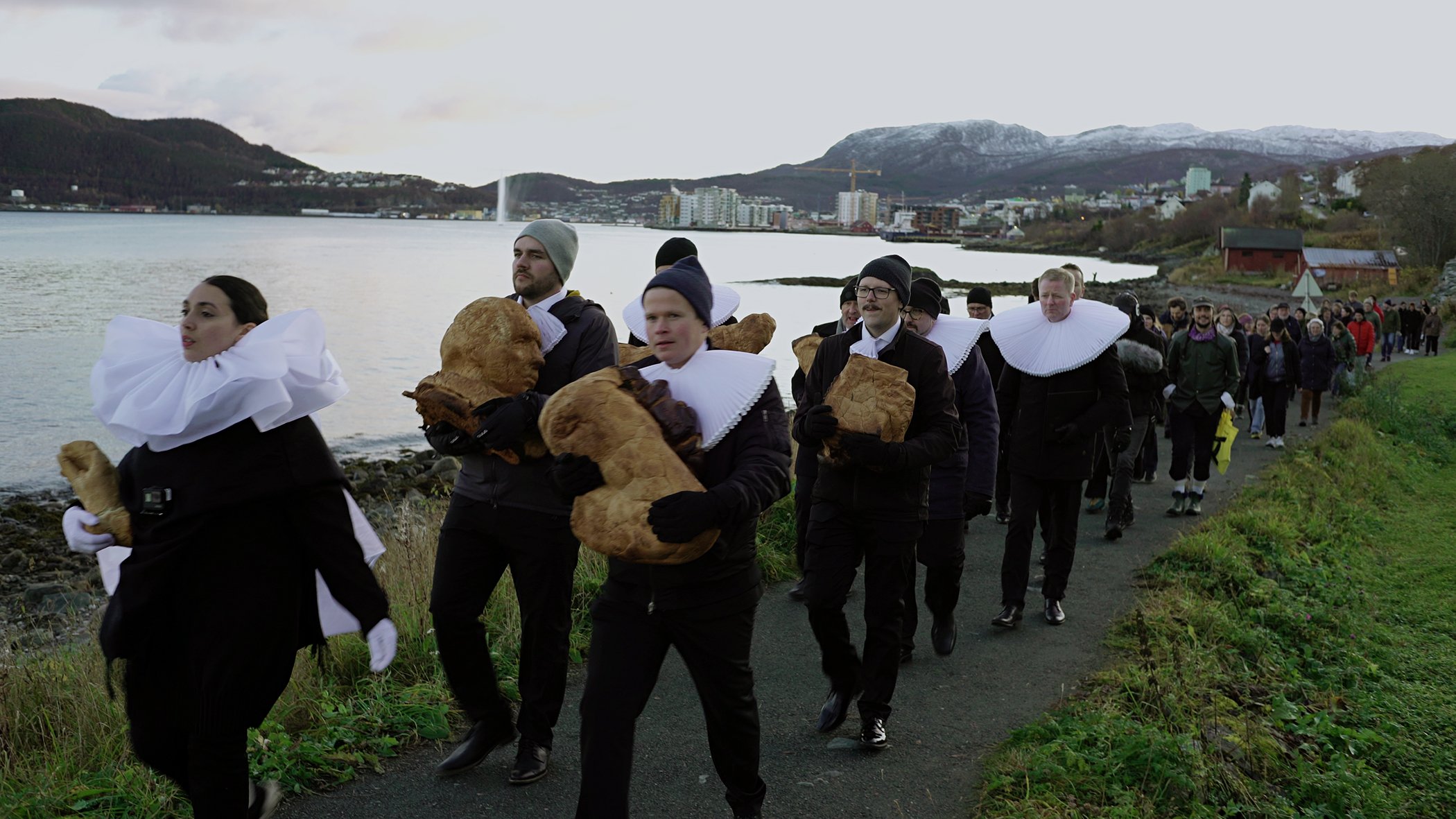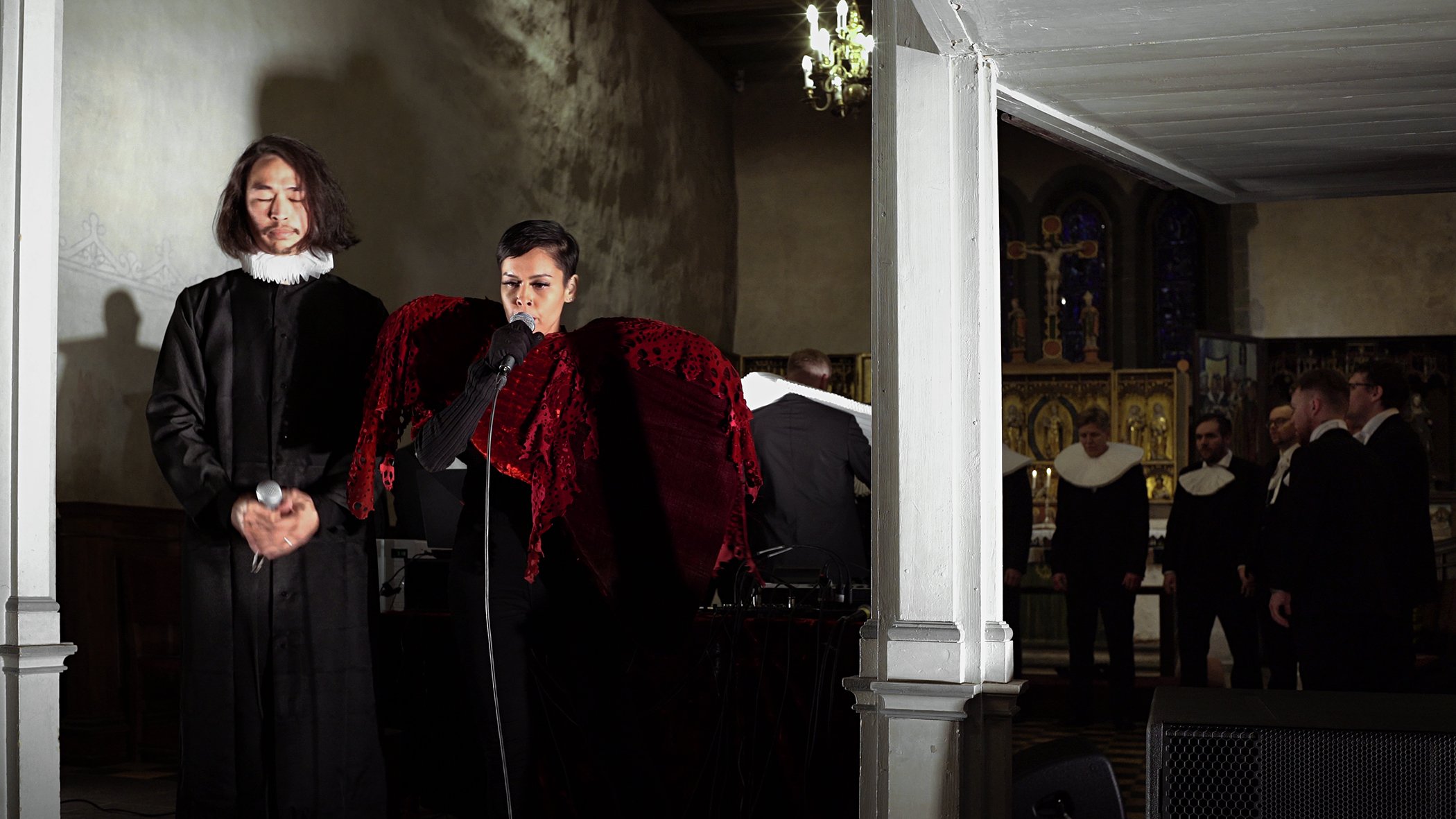STAYING WITH THE HEALING SOUNDS
– by Kata Martincsák (intern at Improper Walls)
“Staying with the trouble does not require such a relationship to times called the future. In fact, staying with the trouble requires learning to be truly present, not as a vanishing pivot between awful or endemic pasts and apocalyptic or salvific futures, but as mortal critters entwined in myriad unfinished configurations of places, times, matters, meanings.”
How can sound explore themes such as gender inequality, sexuality, personal experiences, or collective traumas related to post-colonization? If we take a look at these three performances where the sound became a tool for staying with the trouble - we will probably get closer to the answers. This trouble can be related to the past, some issue that happened a long-long time ago, and at the same time to emerge contemporary problems. As Haraway wrote, even if we are living in disturbing times, staying with the trouble should mean staying in the thick present. But what if this thick present can only be experienced in an alternative reality, even on a new planet?
If we look outside of Vienna’s art scene, we can easily find examples of performances that work with healing sounds. Hanan Benammar’s recent performance in Harstad, This Is Our Body, goes back to history and emerges from the issue of postcolonial trauma. Benammar suggested a new way to handle this trauma as she staged a collective reckoning with the legacy of Greenland’s first colonizer called Egede. We can see the way Bennamar goes in this performance back in time while exploring possibilities for the current situation as an inescapable act to addressing the local issues. She found music as a great medium to mix the Indigenous Peoples’ cultural heritage and the colonizer’s legacy. Incorporating the previously banned Inuit rituals, for example, mask dances, drumming, and throat singing - her piece became a unique mixture of rituals, theatre, and concert. As Bennammar pointed out, these old traumas are staying in the collective memory and they live in our bodies no matter how many generations earlier the wound had been created. With her performance, she offered a new aspect to think about the Inuit trauma and its healing. In the beginning, she started to work with the great musician, Aqqalu Berthelsen, Uyarakq, who has taken part in the community wanting to dislodge the statues of Greenland's great old-colonizer Egede.
Last year, one of the statues was armed with a whip, covered with Inuit signs and red paint, and decorated with the well-known inscription: decolonize.
Hanan Benammar, in her performance, reflected on these statues' historical background. For example, during her piece, the performers carried slices of bread which were sculptures representing Egede’s body pieces. This fact makes us maybe see this piece more as a form of re-enactment, and the possibility for the locals to join the performance further strengthens our intuition. Although it can be seen as participatory art, it was obviously not a re-enactment, but it offered the same possibilities to relate to the past. The way Benammar used the traditional throat-singing, prohibited for centuries although it is an important, identity-defining act for the people who lived there before the colonization- ripped up old sores, while at the same time healing them. The music has an important role during the performance, including sounds from Christianity and the Inuit throat songs – offering a healing experience for the public. The mix of powerful throat singing and electronic music, which included samples of Christian church music played backwards, made a huge contrast, creating a non-existing place where these different sounds can finally meet with each other. The Vienna-based visual storyteller, photographer, and performer Peter Pflügler stays in a similar position as Hanan Benammar when they say our bodies are working as an archive, collecting individual and collective traumas (also transgenerational ones).
This is our body, performance in Harstad 15. oktober 2021. Hanan Benammar and the choir Bel Chorus. Photo: Kristian Skylstad.
The current exhibition at Improper Walls, FOG/ MIST/ MGŁA” also offers a healing experience for the audience as the immersive audio-visual environment intertwines into a response to pain and trauma. But Zosia Hołubowska’s sound design, based on the shooting in Vienna in 2020, also has different connotations due to the lockdown’s circumstances. Daniella Brill Estrada’s visuals supplement the audio work. The carbon-based drawings explore the force intrinsic to every atom responsible for its decision-making mechanism. The two artworks, two different mediums, work together as a new entity, connecting the fears and traumas, and healing them together. The exhibition’s space is filled with fog and Brill Estrada’s visuals are constantly playing through projections. Thanks to the transparent curtains – sometimes visibly, sometimes invisibly, we can see it more abstractly than before.
The exhibition emphasized the importance of the often unspoken topics- such as collective and personal mental health, concerned with traumas of the shooting in Vienna in 2020, and the mental health problems, which often stayed in the unspoken, taboo, blurred fields of our perspective.
The opening performance also used sound as a treatment for current feelings and fears and operated with a lot of different mediums. During the performance, Zosia Hołubowska created entirely new music, while the night gave it a special meaning as we were entering the fourth lockdown in Vienna. The foggy atmosphere, and the sonic healing meditation, which Hołubowska offered us, made Improper Walls a significant place and transformed it into a new, special environment- the planet of Venus, where they can also work with the sound of several crystals.
They also organized and facilitated workshops on synthesizers since 2014 as a founder of Sounds Queer. During their performance, they created a unique audio composition, utilizing simple elements and combining multichannel sound, which will slowly unfold on the senses, creating an immersive, healing experience field recording-inspired environment that will envelop the listeners to face their present. As Hołubowska did before in their performances, they read out from a book, created sounds with the crystals, and transformed the exhibition room into a real healing environment. The participants were allowed to drink tea, which was made by Daniella Brill Estrada, using a special recipe of a Columbian winter-season tea. The distance between the participants was necessary, but thanks to the sound installation and the Columbian tea, it dissolved. Entering deeper and deeper into this experience allowed everyone to be present, connect, meditate, and embrace the healing sound.
Staying with healing sounds was not a new experience for Hołubowska. One of their most recent performances was Amniotic Antidote in Reflektor Gallery. Zosia Hołubowska collaborated with Tina Damgaard & Elena Biner to create the concept of this immersive performance installation, a mixture of a dystopian future and a futuristic healthcare environment. This piece also took place on a fictional planet, a mix of science and artistic fiction in a dystopic universe. They worked with the theme of social alienation and isolation in this new world where all water has been polluted. Amniotic Antidote also explored new methods of treatments, mostly connected with water and natural scientific resources. The performance can be seen as a ritual that combines technology, spirituality, and human connection.
The concept of the show at Reflektor Gallery was written by Tina Damgaard and Elena Biner, and besides Hołubowska, Boeser Ruepel, Joasia Zabielska, Anna Mutschlechner-Dean, Florin Koller, Tina Damgaard and Elena Biner took part of the project, performing all different parts of this illusionary place. The performance also questioned whether using sounds could be an approach to clean water, treating people, and healing this dystopic world. For me, the whole piece was more like a vivid dream, where vulnerability and fragmentation can be seen as normal, as the fluidity of water. The participative part of this performance was especially interesting, as the main task of searching for possible cures can be played as a game. Each participant was invited to explore these game stations, where they also had different tasks to handle. Although all stations connected to the main purpose (to clean the water), the stations also became states of social isolation. Even if the performers showed every step to the participants, they were not allowed to act completely free, and they had to wear a surgical uniform, limiting the possibilities of their actions. At Hołubowska’s station, they offered a game where they grew conductive crystals that polluted the frequency monitor and composed six channels of a soundscape. Connecting art and science, Amniotic Antidote questions our reality, according to the interesting times we live in, struggling with the pandemic, and experiencing social isolation in our own skin.
Donna Haraway’s idea about staying with the trouble may emerge a different approach to these performances, which all worked with healing sounds. The question is not based on the sound effect in our behavior but more on the trouble required to be truly present. If this specific sound can recall bad memories or even traumatic experiences, and at the same time, trigger us to stay in the present- we can feel the beginning of the process of healing. The three performances I wrote about used audio in different contexts, but what was common in them they were played at a different time (or even world than ours). While the performers created a critical aspect and reflected on current problems, using sound to create a healing environment for the audience can be a possible way to stay with the trouble and build up a space for emotional healing.









